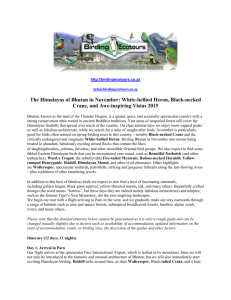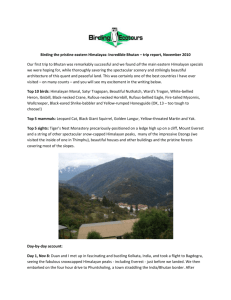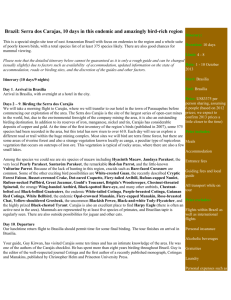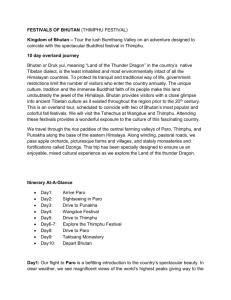The Himalayas of Bhutan in November: White
advertisement
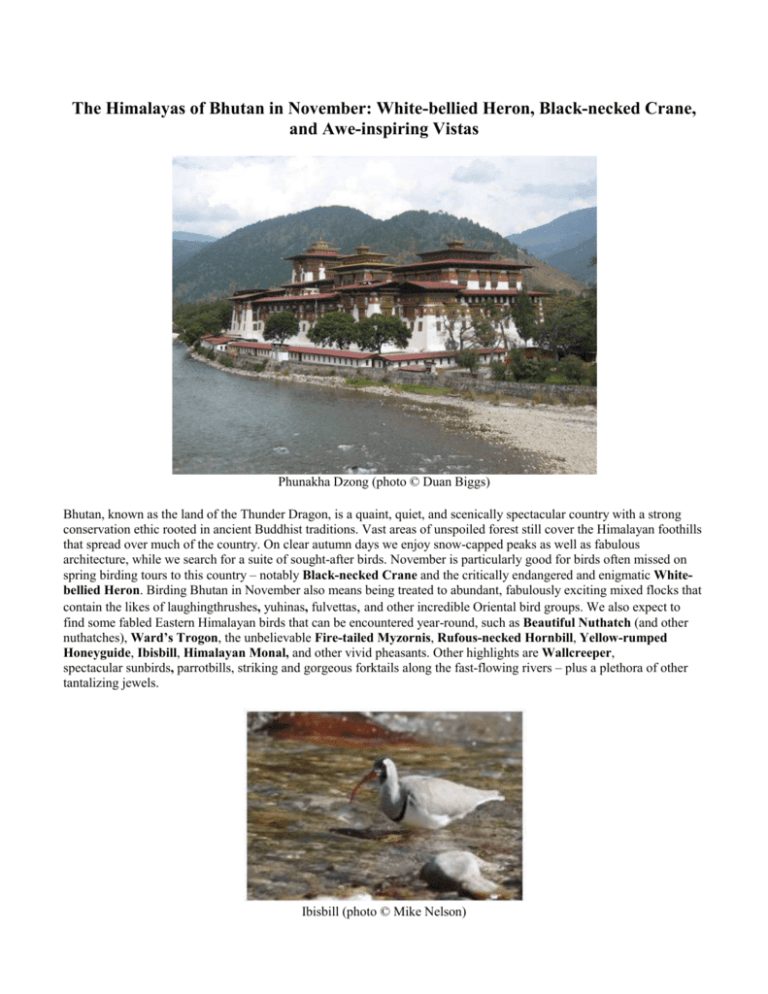
The Himalayas of Bhutan in November: White-bellied Heron, Black-necked Crane, and Awe-inspiring Vistas Phunakha Dzong (photo © Duan Biggs) Bhutan, known as the land of the Thunder Dragon, is a quaint, quiet, and scenically spectacular country with a strong conservation ethic rooted in ancient Buddhist traditions. Vast areas of unspoiled forest still cover the Himalayan foothills that spread over much of the country. On clear autumn days we enjoy snow-capped peaks as well as fabulous architecture, while we search for a suite of sought-after birds. November is particularly good for birds often missed on spring birding tours to this country – notably Black-necked Crane and the critically endangered and enigmatic Whitebellied Heron. Birding Bhutan in November also means being treated to abundant, fabulously exciting mixed flocks that contain the likes of laughingthrushes, yuhinas, fulvettas, and other incredible Oriental bird groups. We also expect to find some fabled Eastern Himalayan birds that can be encountered year-round, such as Beautiful Nuthatch (and other nuthatches), Ward’s Trogon, the unbelievable Fire-tailed Myzornis, Rufous-necked Hornbill, Yellow-rumped Honeyguide, Ibisbill, Himalayan Monal, and other vivid pheasants. Other highlights are Wallcreeper, spectacular sunbirds, parrotbills, striking and gorgeous forktails along the fast-flowing rivers – plus a plethora of other tantalizing jewels. Ibisbill (photo © Mike Nelson) In addition to this host of fabulous birds we expect to also find a host of fascinating mammals, including golden langur, black giant squirrel, yellow-throated martin, yak, and many others. Beautifully crafted dzongs (the word means “fortress”, but these days they are indeed mostly fabulous monasteries) and temples, such as the famous Tiger’s Nest Monastery, dot the awe-inspiring landscapes. We begin our tour with a flight arriving in Paro in the west, and we gradually make our way eastwards through a range of habitats such as pine and spruce forests, subtropical broadleaved forests, bamboo, alpine scrub, rivers, and many others. Please note that the detailed itinerary below cannot be guaranteed as it is only a rough guide and can be changed (usually slightly) due to factors such as availability of accommodation, updated information on the state of accommodation, roads, or birding sites, the discretion of the guides and other factors. Itinerary (12 days, 11 nights) Day 1. Arrival in Paro Our flight arrives at the spectacular Paro International Airport, which is walled in by mountains. Here we will not only be introduced to the fantastic and unusual architecture of Bhutan, but we will also immediately start exciting Himalayan birding. Ibisbill lurks around here, as does Wallcreeper, Black-tailed Crake, and a host of other highly sought-after birds such as the Brown Dipper. Day 2.Himalayan Monal at Chele La We head up a spectacular mountain pass, the famous Chele La, which reaches 4000 meters (about 13000 feet), looking for different specials as we ascend. The biggest prize for most birders is the Himalayan Monal -- famous for its kaleidoscopic vivid rainbow hues. The Monal comes out onto the mountain pass at dawn. But in addition we can find up to four pheasant species today. Other targets include awe-inspiring Himalayan species such as Spotted Laughingthrush, Mrs. Gould’s Sunbird, and Golden Bush Robin. We will look out for flocks of Snow Pigeon, Grey Crested and colorful Green-backed Tits, as well as the fabulous Yellow-cheeked variety. The attractive White-browed Fulvetta is found in most feeding flocks. Also possible are four different redstarts, a variety of rosefinches, White-collared Blackbird, and a plethora of others. Spotted Nutcracker is common here, as it is over much of Bhutan. We descend by lunchtime after a busy day of birding to allow enough time for a walk up to the awe-inspiring Tiger’s Nest Monastery. Overnight: Paro Himalayan Monal at Chele La, Streak-breasted Scimitar-Babbler, Trongsa (photos © Mike Nelson) Day 3. Yellow-rumped Honeyguide and Jigme Dorji National Park An early morning departure sees us head for the capital of Bhutan, Thimphu. En route we search for the enigmatic Ibisbill, Brown Dipper, Ruddy Shelduck, and the local form of Great Cormorant, among others. We will arrive at a section of Jigme Dorji National Park by mid-morning, where we have a stakeout for the tricky Yellowrumped Honeyguide. Also possible here is Kalij Pheasant, Golden-breasted Fulvetta, the elusive Maroon-backed Accentor, and many more. After Jigme Dorji we visit a breeding program for a most-bizarre Himalayan mammal – the takin. It looks like a cross between a giant mountain goat and an antelope! We return to Thimphu in time to search for Black-tailed Crake in the early evening and enjoy some capital city shopping. Overnight: Thimpu. Day 4. Himalayan vistas, Dochula pass, and the Lamperi Royal Botanical Park Today we head east to the Dochula pass, which in autumn typically provides fabulous views of Bhutan’s seven highest Himalayan peaks. Birding here and in the forests below is also impressive, and we will search for the illustriouslooking Yellow-billed Blue Magpie and vividly-colored Warblers such as Whistler’s, Grey-hooded, and Chestnutcrowned. The recently declared Lamperi Royal Botanical Park is our next stop as we descend. It has been amazingly productive on our past tours. The birds here are so good and so many – that it is hard to decide where to look! Our targets at this site include the enigmatic Brown Parrotbill, the vivid Chestnut-capped Babbler, the petite Black-throated Bushtit, Whiskered and Striated Yuhinas, and the colorful Red-flanked Buietail (Orange-flanked Bush Robin). Yellow-bellied Bush Warbler skulks about in the bamboo. Red-billed Leiothrix, Dark-breasted Rosefinch, and many species of Phylloscopus Warblers can be seen here too. Overnight: Wanghdi Phodrang Valley Day 5. White-bellied Heron and the forests of the Mo Chu river We start birding the fantastic Wangdhi Podrang Valley, where we could find birds such as Crested Serpent Eagle, Slaty-backed Forktail, Little Forktail, various flycatchers, Wallcreeper, and a host of others. With luck we might encounter Tawny Fish Owl, and we will start looking for White-bellied Heron , a bird that was historically widespread through the foothills of the eastern Himalayas, but which has declined dramatically and now has a world population of perhaps only 250. Today Bhutan must be the best country for this species, but it is often dipped, especially on spring tours. Whilst searching for the heron we may encounter Spotted and Little Forktails, colorful Common Kingfisher, Upland Buzzard, and the impressive Crested Kingfisher, among many others. After our search for the heron we explore and bird the impressive forests along the Mo Chu river. Here we dive into a further Himalayan birding spectacle with species such as the diminutive yet spectacular Chestnut-headed Tesia, brightly-colored Scarlet, Short-billed, and Long-tailed Minivets, and with luck and some patience Scalybreasted and Spotted Wren-Babblers. This area is also a site for that most tricky of Accentors – the Maroon-backed. Whilst stalking the birds in the forest we will all also keep an eye to the sky for Mountain Hawk-Eagle, Crested (Oriental) Honey Buzzard, and flocks of Himalayan Swiftlet. After this birding spectacle we visit the legendary Punakha Dzong – Bhutan’s most impressive, and currently a monastery. The Dzong is situated at the confluence of the Mo Chu and Mo Po rivers and has been subject to many attacks, floods, fires, and earthquakes since it was built in the 1600s. The beauty and tranquility of this edifice is awe-inspiring to most. Overnight: Phobjika Valley Day 6. Ward’s Trogon, Fire-tailed Myzornis, and the Black-necked Cranes of Phobjika An early start will see us searching for the attractive Rusty-cheeked Scimitar Babbler around our hotel gardens. As we descend and then start ascending again towards the high altitude Pele La Pass we will keep a lookout for roadside attractions such as Chestnut-bellied and Blue Rock Thrushes, and we may encounter White-throated Kingfisher. The roadside forests on our ascent are home to Himalayan specialties such as Bar-winged Flycatcher-shrike, Speckled Piculet, Rufous-fronted Bushtit, and Black-chinned Yuhina. If we have not done so yet, we will start enjoying the attractive busy flocks of Rufous-winged Fulvetta. The Rufous-bellied Woodpecker is always a delight to all. The pass also offers a chance at one of Bhutan’s megabirds – the legendary Ward’s Trogon. The aptly-named Fire-tailed Myzornis may be smaller, but it is no less spectacular. As we ascend higher, the mixed broadleaved forest gives way to stands of rhododendron and coniferous forest, and this is where we start looking out for another Bhutan mega – the remarkable Satyr Tragopan. As we descend into the high altitude valley of Phobjika, we will enjoy one of the world’s rarest Cranes – the Black-necked. Other species here include Tickell’s Leaf Warbler, Rufous-breasted Accentor, large flocks of Red-billed Chough, and Hen Harrier. Ward’s Trogon Black-eared Shrike-Babbler (photo © Mike Nelson) Day 7. Pele La Pass At the top of the Pele La Pass we will search for Great Parrotbill, White-winged Grosbeak, and Greywinged and White-collared Blackbirds. Your guide will keep a constant eye to the sky for Himalayan Vulture, Steppe Eagle, and Long-legged Buzzard among other ‘raptorian’ delights. As we descend again towards Trongsa, roadside stops may yield colorful Sunbirds including Fire-tailed, Mrs. Gould’s, and Green-tailed, Collared Owlet, bustling flocks of White-throated Laughingthrush, and the striking Streak-breasted Scimitar Babbler. We will keep a lookout for flocks of Common and Nepal House Martins. Day 8. Birding the spectacular mountain passes of Zhemgang The road towards Zhemgang must be one of the most spectacular birding roads on the planet. Sheer drop-offs to thousands of feet far below make for a most memorable of birding experiences. The forests and forest edges host a plethora of outstanding species, including Slaty-backed Forktail, the delicately-colored Rufous-necked Laughingthrush, the gaudy Common Green Magpie, the sizeable Blue-bearded Bee-eater, the striking Rufousbellied Niltava, and, with a bit of luck, the forest-patrolling Rufous-bellied Hawk-Eagle. A highlight for many is likely to be the conspicuously-plumaged Sultan Tit. Our campsite at Zhemgang is phenomenally located high atop a Himalayan ridge next to a Buddhist chorten (a mound-like structure containing Buddhist relics) overlooking the valleys far below. A night walk from our camp may deliver Mountain Scops and Brown Wood Owls, and the mysticallooking black giant squirrel. Overnight: Camping, Zhemgang Yellow-billed Blue Magpie (photo © Mike Nelson) Days 9 - 11. Beautiful Nuthatch, Slender-billed Scimitar Babbler, and more The elegantly-plumaged Beautiful Nuthatch is one of our main targets in Zhemgang. Birders are likely to be equally awed by the gigantic and noisy Rufous-necked Hornbill, and the Great Hornbill is also a common sight as we descend towards our campsite at 600m altitude in Tingtibi. These ‘low altitude’ forests provide opportunities for many a delightful species: Long-tailed Broadbill, Orange-bellied Leafbird, White-browed, Coral-billed, and Slender-billed Scimitar Babblers, Grey-bellied Tesia, Mountain Tailorbird, Brown-throated Treecreeper, and the extravagant Crimson Sunbird. We will spend time chasing skulkers including Blue-winged Laughingthrush, the aptly-named Golden Babbler, and troops of exotic-looking golden langurs scurrying through the forest canopy, while noisy flocks of iconic White-crested Laughingthrushes scour the forests for grubs lower down. After relishing these impressive species we return to Trongsa. Overnight: Tsonga Day 12. Trongsa to Paro, departure Today we will be driving day back to Paro for our flights home. Itinerary: Duration: 12 days Limit: 4-8 Date: 1 - 12 November 2013 Start: Paro, Bhutan End: Paro, Bhutan Price: US$4916 per person sharing, single supplement US$670. Price includes: Accommodation Accommodation All meals International guide Price excludes: International flights Alcoholic beverages Personal insurance Gratuities Laundry service Personal expenses such as gifts
